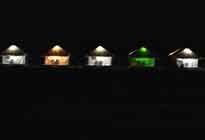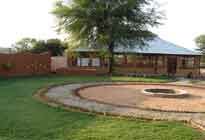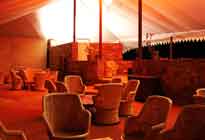| The Fort View Camps
Alwar, Rajasthan. |
|
|
The Sariska is located in Alwar district of Rajasthan. and can be considered a central point for visiting various attractions within its vicinity. Located close to Sariska are three old settlements Bhangarh Fort, Ajaibgarh and Pratapgarh. The Sariska terrain has taken roots in this semi arid deserts of Rajasthan and supports scrub-thorn arid and dry deciduous forests that are full of rocks and grass patches intertwined with some thick foliage. The wildlife present in the area is diverse and is a perfect example of adaptability and symbiosis between nature and animals. The climate, as in any desert, is dry and varies towards the extremes. The place is also famous for old temples and palaces around the sariska. The temples and chhattris and even the rare waterfall offer an exquisite view. However, the ruins of many of these monuments only serve as a reminder of how glorious the history of this land has been. |
|
|
Sariska provides an opportunity to view tiger, langur, nilgai and various many bird species. However, apart from the wildlife and forest Sariska is surrounded by numerous places of historical interest, interspersed with temples and monuments. Enjoy the famous Sariska Tiger reserve in these forests, once a part of the ancient 'Matsya' kingdom, are also supposed to have sheltered the exiled Pandavas. It is believed that Bhima, smote the rock face of a cliff with his cudgel at Pandu Pol and made a passage through a gorge in the sanctuary. The sight of the huge gaping orifice with a picturesque spring emerging from the rocks, is an awe-inspiring sight. While in Sanctuary, trek on the numerous rugged hills and explore the ruined palaces located atop them. The mornings and evenings are the busiest periods in a day and the same holds true even in the forests. The Jungle Safari organized for groups from the guest house or from the entrance is a thrilling ride full of amusement and trepidation throughout. It's the dawn and dusk period when the wildlife ventures out of compulsion towards one of the many water holes scattered around the Park. The Game is not the correct word to describe these extremely beautiful creatures that roam fearlessly in their own domain thus providing the tourists the best chances of an awe inspiring spectacle. |
|
| |
 |
|
|
Sariska National Park |
|
Sariska Tiger Reserve is an area of 800 sq. kms. Sariska was declared a sanctuary in 1955 and it became a Tiger Reserve under Project Tiger in 1979. Sariska, with its awe inspiring craggy canyons and the tropical dry deciduous scrub jungles and limited water supply, was the western limits of the distribution of the tiger in India. Tigers could be seen in the area even during the day time till 2002 or so. But unfortunately, due to poaching and many other reasons Tigers have disappeared from Sariska. The State Government started an all out effort to re-introduce Tiger in Sariska under the technical supervision of the Wildlife Institute of India and has sent the detailed proposals, to Government Of India, for Re-introduction of Tigers in Sariska. Finally Sariska got a Tiger Couple in July 2008. Sariska is a special Tiger Reserve also because the natural history of the ecosystem combines with the rich history of the country. The ruins of Shiv temples and a few Jain temples that exist in the archaeological complex of Garh Rajore, belong to a period between 8th and 10th century. The abandoned fort of Kankwari tells of the grim story of the Moghul Empire , where Prince Darah Shikoh was kept in prison for years by his younger brother Aurangzeb. Pandupole, with a legend of Pandava period, Narainimata temple and Bharthari temple are the centres of attraction for thousands of pilgrims. |
|
| |
 |
|
|
Terrain
|
|
The terrain of Sariska is hilly with numerous valleys, both wide and narrow, and expansive undulating plateaus. The characteristic features of the Aravalli range - sharp hog -black ridges - are conspicuous in the Reserve. Most of the high ridges are composed of quartzite conglomerates and grits.
Flora:
The forests are of a typical dry deciduous type with Dhok as the dominant tree species of gentle to moderate slopes constituting over 90% of the tree canopy. The ridges support Salar on steep dry slopes. Khair and Cheela occur in vally beds. Bamboo grows to a limited extent along moist and cooler parts. Aam, Jamun, Arjun and Bahera, which grow in moist depression and on nallah banks attain large sizes. The ground cover is mainly Ber, and Adusa. Zizyphus and Grewia are good fodder species. The dried and fallen leaves of Dhok help the herbivores to tide over the fodder scarcity during summer months. The forests become lush green in the monsoon months and completely dry in the summer months. |
|
| |
 |
|
|
Fauna
|
|
Sariska is very rich in wild animals. Panther, Hyena, Jackal and Jungle cat are the carnivores of the forest. Caracal and Wild dog are seen very rarely. Among the prey population are the Sambhar, Chital, Nilgai, Wild boar, Hare and Porcupine etc. Sariska is unique in animal distribution. The wild animals here seem to have decided their area -limits. Slopka is best for observing the Sambhar, Kundli for Chitals and Tarunda & Kalighati for Nilgai. Four -horned antelopes or chausingha can be seen in the Pondupole Nallah. Chausingha is exclusively Indian and is the only buck on earth with four horns. Sariska is also famous for its population of common Langurs and the Rhesus monkeys. Talviksh is where the main population of Rhesus exists and one can see hundreds of them at a time. Langurs can be seen in large numbers at Pandupole, slopka and Kalighati as well. In sariska, observing Wildlife at the water holes is quite fascinating during the hot days of April, May and June. Water requirements increase and Wildlife activities get restricted to the water holes,specially around Kalighati and Slopaka. Sambars, Chitals, Nilgais, Chausinghas, Jackals, Wild boars, Langurs etc. visit water holes throughout the day. The predators appear around dusk or during the silence of the night. |
|
| |
 |
|
|
Birds
|
|
For the ornithologists and birding enthusiasts, the natural surroundings of Sariska draw the migratory birds from Siberia and China. It is quite a mingling of horned owl, tree pie, grey partridge, woodpecker, peafowl, crested serpent eagle, bush quail, sand grouse. Probably, Sariska is the richest Tiger Reserve as far as avifauna is concerned. More than 225 species of birds can be seen here. The populations of Peafowl, Grey partridges and Bush quail are conspicuous. Other commonly seen birds are Parakeets, Red spurfowl, Doves Green pigeon, Flycatchers, Bee-eaters, Shrikes, Woodpeckers Vultures and Nightjars etc. Trees Checklist of Sariska:
Dhok (Anogeissus pendula) is the dominanat tree species covering over 90 per cent area of the forest. Boswellia serreta and Lannea cormandalica grow at rocky patches. Kattha (Acacia catechu) and Bamboo are common in the valleys. Some valleys support Palas (Butea monosperma) and Ber (Zizyphus spp.). Besides these, some noteworthy tree species are Arjun (Terminalia arjuna), gugul (Commiphora wightii), Kadaya (Sterculia urens), Amla (Emblica officinalis), Bahera (Terminalia belerica). |
|
| |
 |
|
|
Birds
|
|
"Walk around the beautiful green carpet early in the morning with the resident Naturalist. During afternoon enjoy beautiful scenery sitting in the verandah. As the Sun Sets, Sit under the starlit sky around a roaring bonfire and enjoy". .....reach us .... Just 03 hours from Delhi. Sariska - The Fort View Camps . is amidst the beautiful hillocks of Aravalis and unending lush farming field. A campsite with 04 cottages and 14 canvas tents raised on a concrete platform and are custom made along with 52 covers restaurant specializes in serving Indian and local cuisine. Leisure Activities/ Recreational Facility, Folk music and dance entertainment can be organized on request for the visiting groups. Verandah for relaxing, snacking, chatting. Picnics at nearby, beautiful lakes. Bonfire. Library-books on wildlife. Recreational centre. Indoor games. Telephone facility. The camp site is very well laid out with lots of green space / play ground for children and adults alike. We do not have ACs but pedestal fans which are enough for the day time ( Beginning October and Mid March onwards ) and not required in the night as it will be cool. Have good quantity of cricket bats, wickets, tennis balls. Chess, Carrom, Playing Cards, Badminton rackets, Volleyball and footballs are also available for use. Beach Volleyball and mud wrestling are also there although later will need some advance preparation!. The days are Cozy, but the nights are cool. So, if you are planning to sit in the open (for drinks etc) after 2100, hrs, advisable to carry some light jackets/shawls. Please carry your own books (if into reading) or walkmans/ipods (if into music). FM does not work here. There is not any TV as yet. Have hot and cold running water in tents, but since the water is heated by solar energy, it may be a little cool in the morning. Please also carry your caps/hats and sunglasses if you plan to do outdoor activities like cricket etc. A small torch can also come in handy as the power supply is unpredictable. Being a campsite near a village, we have have hired the local villagers as staff. So, although the service, standards may not be of very high standards, people are very courteous and helpful. Also, you will need to appreciate the slow pace of things there as that is what the whole idea behind this place and your outing is about - slowing down a little bit!, Although you may not have time to think going out of the camp, yet we can provide a short trek to the nearby fort through the countryside. But this should ideally be taken in the early morning as after 1000 hrs it starts getting warm. |
|
| |
 |
|
|
Excursions and activities
|
|
Kankawari:
If Rajasthani sand speaks about the tales of friendship and brotherhood then it is also full of tales of betrayal and sibling rivalries. The Fort of Kankwari stands witness to one such bloody battle between the two sons of The Mughal Emperor Shahejahan. Dara Shukoh, Shahejahan's youngest son had used the Fort of Kankwari as his last hiding resort before fate caught up with him in the form of his brother Aurangzeb. This magnificent fort lies within the barriers of the Sanctuary around 25 Km from the entry point. The route to the fort is full of huge boulders and troughs throughout the way. The striking terrain of green landscapes and fertile meadows surrounding the fort create a pleasant welcome for the tourists. Naldeshwar:
The land of warriors cannot be spared by places of worship. The temples of Rajasthan are a class apart and the temple of Naldeshwar near Sariska is a masterpiece. The temple is located at some distance off the highway joining Sariska to Alwar. The temple itself has to be approached on foot after reaching the alighting point on the highway. The Naldeshwar shrine is dedicated to and houses an old Mahadev (Lord Shankar/ Shiva) temple. The shrine is surrounded by thick greenery and the walk to the shrine and the time spent in this pristine environment is worth every second spent. The thick forest cover, the 18th century temple and the peaceful natural habitat brings out the spiritual best from every visitor. Neelkanth:
Continuing with the temple pilgrimage the Neelkanth Mahadeva temple town located in the vicinity of Tehla, is famous for accommodating ruins of more than 300 temples dedicated to the Hinduism and Jainism. These temples believed to be constructed between the 7th and the 12th centuries resemble the carvings of Khajuraho (Chandelas). The temples are an awe inspiring example of the artistic glory that prevailed in the area even a millennium ago. The idols, the temple yards and architecture have been so delicately crafted that the feat without use of any scientific instruments is unthinkable even today. |
|
| |
 |
|
|
Excursions and activities
|
|
Jai Samand Lake (35 kms. from alwar):
Not only is Alwar blessed with green hills, it also has several beautiful lakes in its vicinity. The best time to visit them is, of course, the monsoon. The lake nearest to the city is the Jai Samand Lake, created in 1910 by Maharaja Jai Singh of Alwar as a picnic spot. He even built a large island in its midst that has lasted these 96 years. But the prettiest sight at the lake is the string of canopied pavilions lining the promenade. The Jai Samand Road is terrible and instead of testing the resilience of autos, hire a cab for a Jai Samand-Siliserh-Alwar round-trip (Rs 400) that shouldn't take more than 4-5 hrs. There is no accommodation at the lake.
Siliserh Lake (26 kms.):
The most famous and, no doubt, most beautiful of the lakes around Alwar was formed in 1845, during the reign of Maharao Raja Viney Singh, who dammed a tributary of the River Ruparel. The lake spreads over 10.5 sq km during monsoon, and is a marvellous sight with green hills around it and white clouds above. How To Reach
By Air
Sanganer Airport located at Jaipur is nearly 101 km from Sariska. Taxi charges about Rs 2000 from Airport to the sariska. Jaipur airport is connected to metro cities Mumbai and Delhi. Travelers can take connection flights from Delhi international airport, which is nearly 240 km away from Sariska. By Train
Alwar is the nearest railway station to Sariska. This railhead is on the Broad Gauge line between Mumbai and Delhi and is connected to all cities in India by trains. By Bus
Sariska is connected by regular bus services to other cities in and around. Many public transport buses connecting Sariska with Jaipur (100 km) and Alwar (36 km). Private bus services are available from Sariska to Delhi (200 km). |
|
| Packages |
1 Night / 2 Days Packages
Deluxe Tent Rs.6555/-
Extra Adult Rs.2200/-
2 Night /3 Days Packages
Deluxe Tent Rs.12555/-
Extra Adult Rs.4400/-
Includes: Accommodation for 2 Person 2 Child below 10 yrs complimentary Welcome Drink on Arrival Fruit Basket in the camp Buffet Breakfast & Dinner Morning / Evening Tea Evening Snacks & All Taxes. |
|
|
| |
|
|
|
|
|
Tele : +91-11- 41612107, 26823836. Mobile: 9810002772, 9910002772. |
|
|
|
|
|
|
|
|